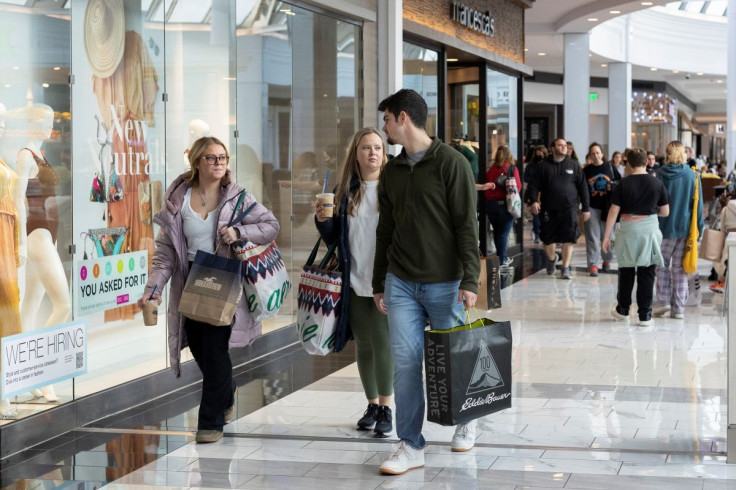U.S. Inflation Simmers, Worst Of Price Gains Likely Behind

U.S. consumer price growth slowed sharply in April as gasoline eased off record highs, suggesting inflation has probably peaked, though it is likely to stay hot for a while and keep the Federal Reserve's foot on the brakes to cool demand.
That aspect was reinforced by the report from the Labor Department on Wednesday, which also showed underlying monthly inflation pressures building up again after a lull in March as airline ticket prices notched their biggest increase on record. Rents rose by the most since 2006, further squeezing consumers who also paid more for food and healthcare.
"The country's struggle with high inflation isn't over yet, but the markets can still breathe a sigh of relief that it is not getting any worse," said Christopher Rupkey, chief economist at FWDBONDS in New York. "The Fed can stay on plan with 50 basis points rate hikes in June and July and there is no reason to move more expeditiously to fight inflation."
The consumer price index increased 0.3% last month, the smallest gain since last August as gasoline prices fell 6.1% after soaring 18.3% in March. That stood in sharp contrast to the 1.2% month-to-month surge in the CPI in March, which was the largest advance since September 2005.
The drop in gasoline blunted a 0.9% increase in food prices. The rise in food prices was broad, with the cost of dairy and related products surging 2.5%, the largest gain since July 2007.
Economists polled by Reuters had forecast consumer prices gaining 0.2% in April. But the deceleration in the monthly CPI is probably temporary. Gasoline prices are rising again and were averaging $4.404 per gallon on Wednesday after hovering just above $4.00 in April, according to AAA.
Russia's unprovoked war against Ukraine is the main catalyst for the surge in gasoline prices, and has also driven up global goods prices.
Inflation was already a problem before Moscow's Feb. 24 invasion of Ukraine because of stretched global supply chains as economies emerged from the COVID-19 pandemic after governments around the world injected large amounts of money in pandemic relief and central banks slashed interest rates.
President Joe Biden on Wednesday again acknowledged the pain inflation was inflicting on American families and reiterated that bringing prices down "is my top economic priority."
The Fed last week raised its policy interest rate by half a percentage point, the biggest hike in 22 years, and said it would begin trimming its bond holdings next month. The U.S. central bank started raising rates in March.
Stocks on Wall Street rebounded following a recent drubbing. The dollar fell against a basket of currencies while U.S. Treasury prices were mixed.
ANNUAL INFLATION PEAKED
In the 12 months through April, the CPI increased 8.3%. While that was the first slowdown in the annual CPI since last August, it marked the seventh straight month of increases in excess of 6%. The CPI shot up 8.5% in March, the largest year-on-year gain since December 1981.
Annual readings are likely to subside further as last year's large increases fall out of the calculation, but remain above the Fed's 2% target at least through 2023. A shift in demand back to services from goods is also seen cooling inflation.
But risks are skewed to the upside, with China's zero tolerance COVID-19 policy and the dragging Russia-Ukraine war putting more strain on global supply chains. Demand for services like air travel and hotel accommodation over the summer as well as worker shortages could keep inflation elevated.
"We remain nervous about the impact from gasoline and the growing price pressures within services," said James Knightley, chief international economist at ING in New York.
Excluding the volatile food and energy components, the CPI accelerated 0.6% after climbing 0.3% in March. The so-called core CPI rose 6.2% in the 12-months through April. That followed a 6.5% jump in March, which was the largest gain since August 1982. A key measure of rents, owners' equivalent rent of primary residence, surged 0.5% last month. That was the biggest increase since June 2006 and followed a 0.4% rise in March.
Underlying inflation pressures were also fanned by airline fares, which soared a record 18.6% because of strong demand and high jet fuel prices. Hotel and motel accommodation also cost more as did recreation and household furnishings.
New motor vehicle prices accelerated 1.1% in part as the government shifted from surveying dealerships to using transaction data to calculate price changes.
Americans also paid more for healthcare, with the cost of hospital services increasing 0.5%, though prices for prescription medication were unchanged.
Core services prices, raced 0.7%, the most since August 1990, which economists said was evidence of soaring labor costs being passed on to consumers. They argued that a wage-price spiral would be hard for the Fed to combat without stalling growth or pushing the economy into recession.
"With services prices continuing to rise further, it will likely be increasingly hard for the Fed to deny that this wage-price spiral dynamic is taking place, and recognition of that would be a further hawkish risk," said Veronica Clark, an economist at Citigroup in New York.
But consumers got some relief, with apparel prices falling 0.8%. The biggest drop there since May 2020 ended six straight months of increases.
Communication costs fell for a third consecutive month, while prices for used cars and trucks declined 0.4%.
© Copyright Thomson Reuters 2024. All rights reserved.




















